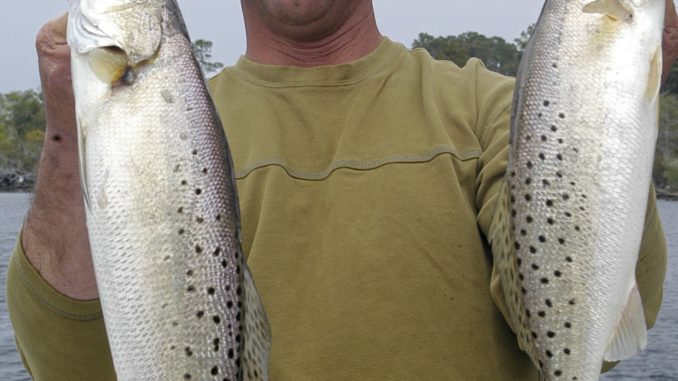
Speckled trout harvest was lowest on record
Although a news release from the North Carolina Division of Marine Fisheries paints a rosy picture of saltwater harvests, a look at some of the details, especially those not included in the report, will alarm many observers.
NCDMF reported that commercial and recreational saltwater fishing harvests increased during 2010, to its highest since 2005. However, those numbers may reveal more about the efficiency of commercial gear and the popularity of recreational fishing than good management practices.
Commercial seafood harvests made a 4-percent jump, despite a 3-percent decline in the number of commercial trips taken. Commercial fishermen took 152,084 trips in 2010 and decked 72 million pounds of finfish and shellfish with a dockside value of $80 million. That was a 3-percent increase from the previous 5-year landings’ average of 70 million pounds.
Recreational fishing, according to a computer model used by NCDMF that relies on dockside and phone surveys, saw a 6-percent increase after a 15-percent decline in 2009. The last time the number of recreational trips was estimated, 2006, almost 7.1 million trips were taken, generating $963,851,000, producing $1.6 billion in economic activity – outstripping the value of finfish and shellfish as commercial targets by 1200 percent.
“The increase (in harvests) is a surprise considering increased regulations, including many seasonal closures, imposed by the federal councils and the National Marine Fisheries Service, as well as restrictions from the sea turtle lawsuit settlement,” Dr. Louis Daniel, director of NCDMF, said in a news release. “Additional increases in fuel and commodity prices might have been expected to actually cause the numbers to decline.”
Included in the commercial gains was an 8-percent increase in shellfish, shrimp and crab landings, plus an 81-percent jump in oyster landings. Oystermen sold to seafood dealers more than one million pounds of oyster meats (196,661 bushels), with a dockside value of about $5 million, in 2010. Those andings were 125-percent higher than the previous 5-year average and corresponded to a 139-percent increase in the use of oyster dredges, Daniel said. However, oyster dredges are a bottom-destroying gear that, when used over time, can eliminate underwater oyster beds.
Blue-crab landings increased in 2010. Fishermen sold 30.7 million, a 2-percent increase from 2009, with a dockside value of $26.5 million. Blue crabs remained the state’s top commercial seafood in pounds harvested and dockside value, followed by Atlantic croaker (7.3 million pounds), shrimp (6 million pounds), summer flounder (3.3 million pounds) and bluefish (3.2 million pounds).
The NCDMF report didn’t mention spotted seatrout, which have been classified as depleted for the past two years. Specks are suffering greatly in inshore coastal waters because of two straight years of winter cold-stun kills and increased fishing pressure – they are the third-most sought-after fish in North Carolina inshore waters, ranking only behind flounder and spot, with 70 percent of recreational anglers surveyed pursuing them.
Omitted from the news release, the speckled trout overview for 2010 contains dismal news. Commercial netters landed only 162,775 fish, a 312-percent decrease from 2009. The drop in commercial poundage was from 833,568 to 326,757 pounds, a 250-percent decline. In short, the 2010 commercial catch of speckled trout was the lowest on record. In response, the NCDMF closed recreational fishing for specks from Feb. 17 until June 15, but the N.C. Marine Fisheries Commission allowed commercial netting after a month-long closure, with landings not to exceed 50 pounds per net set.
Speckled trout, red drum, and striped bass are part of a gamefish designation bill (H 353) that would protect them in the future from netting for sale.
Like speckled trout, southern flounder landings decreased by 29 percent in 2010. Although the NCDMF attributed much of the decrease to a 45-percent reduction in flounder gill-net landings and a settlement in the sea-turtle lawsuits, southern flounder have been listed as depleted for years by agency biologists. And while NCDMF has reduced recreational creel limits to six fish per day and increased the legal keeper size limit to 15 inches, it still allows inshore netters to target these fish. In 2010, 234,571 netters were netted and sold, an 86-percent increase over 2009 levels. In poundage, the increase jumped from 297,786 to 512,389 pounds.
Although recreational catches of Atlantic croaker and bluefish increased by 19 percent and 36 percent, respectively, offshore catches dropped for dolphin (61 percent), king mackerel (58 percent), tuna (yellowfin, 33 percent; bigeye, 43 percent; and bluefin, 65 percent). The NCDMF attributed the drops to the increased cost of fuel and, in the case of bluefins, lack of availability. Inshore landings of Spanish mackerel also dropped 35 percent.
Striped bass catches increased because more fish migrated into North Carolina waters this past winter than in previous years. Striper catches jumped 239 percent to 711,184 pounds. Bluefish landings also jumped 21 percent (to 1.2 million pounds)
“There was an overall shift in recreational fishing effort in North Carolina to trips that were less expensive,” said Doug Mumford, NCDMF’s statistical research coordinator.
Recreational fishing trips rose by about four percent from piers and other man-made structures; by about eight percent from the beach or bank; nearly 10 percent from guide and charterboats; and nine percent from private vessels. Party-boat trips decreased by 15 percent.





Be the first to comment